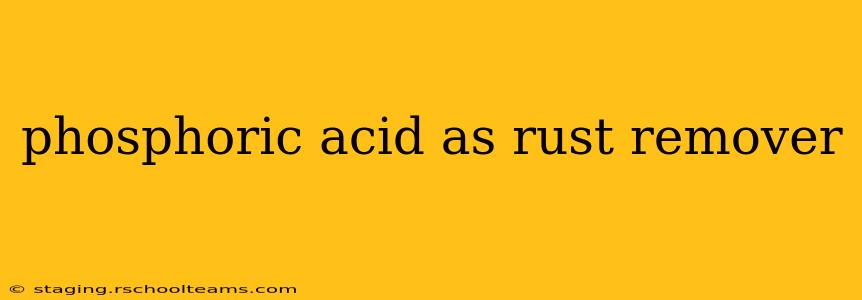Phosphoric acid is a highly effective rust remover, popular among DIY enthusiasts and professionals alike. Its ability to convert iron oxide (rust) into a protective phosphate layer makes it a superior choice compared to many harsh chemical alternatives. This comprehensive guide delves into the effectiveness, safety precautions, and various applications of phosphoric acid in rust removal.
What is Phosphoric Acid and How Does it Remove Rust?
Phosphoric acid (H₃PO₄) is a weak, non-toxic acid naturally found in many foods. In rust removal, it acts as a chemical converter. It doesn't just dissolve the rust; it reacts chemically with it, transforming ferric oxide (Fe₂O₃, the main component of rust) into a stable, water-insoluble iron phosphate layer. This layer adheres to the metal surface, providing a degree of corrosion protection and creating a good base for painting or other finishing treatments. This process is called phosphating or chemical conversion coating.
How Effective is Phosphoric Acid at Removing Rust?
Phosphoric acid's effectiveness is highly dependent on several factors: the severity of the rust, the type of metal, and the concentration of the acid solution. Light to moderate rust can often be completely removed with phosphoric acid, leaving behind a clean, protected surface. However, for heavily rusted items, it may only partially remove the rust, requiring additional cleaning methods before finishing. It works particularly well on ferrous metals (iron and steel).
Is Phosphoric Acid Safe to Use?
While generally considered less hazardous than many other strong acids, phosphoric acid is still a chemical and requires careful handling. Always wear appropriate safety gear, including gloves, eye protection, and a respirator (especially in enclosed spaces or when dealing with large quantities). Ensure adequate ventilation to prevent inhalation of fumes. Proper disposal of the spent acid solution is also crucial; consult local regulations for safe disposal procedures. Skin contact should be avoided, and in case of contact, immediately rinse the affected area with plenty of water.
What are the potential dangers of using phosphoric acid?
The potential dangers of using phosphoric acid include skin irritation, eye irritation, and respiratory irritation. Ingestion can also cause serious health problems. Therefore, careful handling and adherence to safety guidelines are paramount.
What happens if you get phosphoric acid on your skin?
If phosphoric acid contacts your skin, immediately rinse the affected area thoroughly with plenty of water for at least 15 minutes. Remove contaminated clothing and wash it before reuse. If irritation persists or is severe, seek medical attention.
Is phosphoric acid harmful to the environment?
Phosphoric acid itself isn't considered highly toxic to the environment, but improper disposal can lead to water contamination. Always follow local regulations for the disposal of spent phosphoric acid solutions.
What are the different ways to use phosphoric acid for rust removal?
Phosphoric acid is available in various forms, including liquid solutions (often marketed as rust removers) and gel formulations. It can be applied using brushes, rags, or immersion, depending on the item and the severity of the rust.
Can I use phosphoric acid on all metals?
No, phosphoric acid is primarily effective on ferrous metals (iron and steel). Its effectiveness on other metals is limited, and in some cases, it can cause damage. Avoid using phosphoric acid on aluminum, zinc, or other non-ferrous metals.
How long does it take for phosphoric acid to remove rust?
The time required for phosphoric acid to remove rust varies greatly depending on factors like the concentration of the acid, the severity of the rust, and the temperature. It can range from a few minutes to several hours. Regularly checking and cleaning the item is recommended.
What should I do after using phosphoric acid to remove rust?
After rust removal with phosphoric acid, thoroughly rinse the item with clean water to remove all traces of the acid. Allow it to dry completely before applying any further treatments like paint or primer. The converted phosphate layer acts as a good base for paint adhesion.
This guide offers a comprehensive overview of using phosphoric acid as a rust remover. Remember to always prioritize safety and follow the instructions provided on the product label. By understanding its properties and limitations, you can effectively utilize phosphoric acid to restore metal surfaces and protect them from further corrosion.
